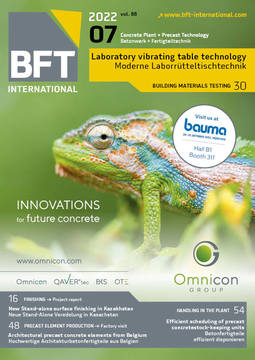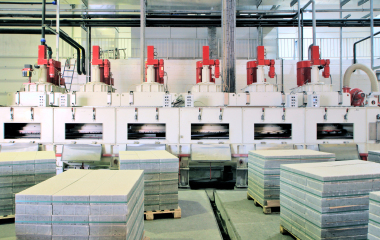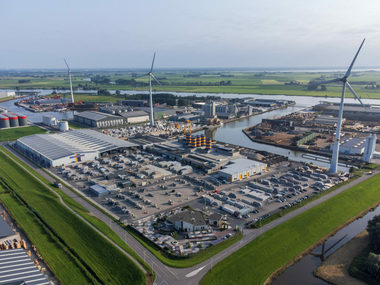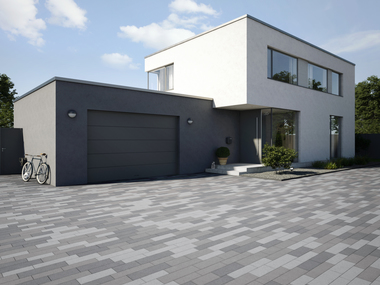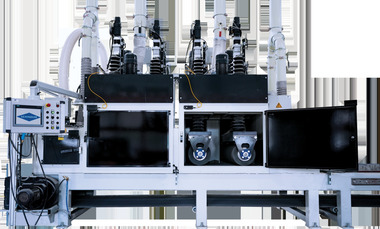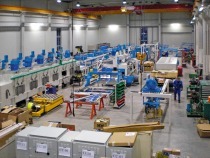New Stand-alone surface finishing of
SR Schindler in Kazakhstan
After an impressive visit to SR Schindler for the guests, the Regensburg-based plant manufacturer was commissioned with the delivery of a Stand-alone surface finishing plant for Avers, a concrete block manufacturer based in Nur-Sultan, Kazakhstan. In the end, all parties involved were very satisfied.
The companies Avers and SR Schindler met for the first time in December 2019 in St. Petersburg, where Avers visited the booth of Topwerk Group and expressed immediate interest in the finishing of concrete blocks. Both parties exchanged relevant information and arranged a tour to Germany for Spring 2020. Fortunately, this trip took place before the entry and travel bans due to the Corona pandemic. Ilya Andreadi and Nikolay Popandopulo of Avers came to Germany to visit several finishing plants of SR Schindler in March 2020. They were so impressed by these visits that they requested a quote and a layout. Final discussions were completed at SR Schindler in Regensburg as early as September 2020, and the contract for a stand-alone surface finishing line was signed on Oct. 19, 2020.
An existing hall was extended for the finishing line. Due to the limited building ground and the conditions of the existing hall, the new hall construction and the finishing line had to take these restrictions into account. The products are fed in and out via two-layer stacking devices, each with a trolley with an electric motor-driven 4-sided clamp. Both layer stacking devices are mounted in a line on the same side. The calibration-grinding line and the shotblasting-curling-coating line are therefore each U-shaped. Since only one packaging line has been designed, the calibration grinding line and the shotblasting-curling-coating line cannot be operated independently of each other at the same time. Either the products pass through both lines in combination, or only one of the two lines is used for production and subsequent packaging.
The working width of the line is 1,200 mm. The smallest single stone within a layer measures 100 x 100 mm. All products have spacers. The products are transported in packs on transport pallets on a heavy load roller conveyor to the destacking position. They are taken layer by layer from the 1st layer stacking device and placed on the hydraulic lifting table of the calibrating-grinding line or a slat conveyor. The slat conveyor transports the layers to the infeed position of the shotblasting-curling-coating line.
The empty transport pallets are removed via an angular transfer and brought to the underfloor empty pallet transport via a lifting/lowering table. At the end of this empty pallet transport, another lifting/lowering table brings the empty transport pallets back to the top, and via an angular transfer, to the loading position. After quality control, all finished product layers - regardless of which finishing process they have passed through - are reassembled into packages exclusively at this position and then packaged. The transport pallets can also be stored on the approx. 16 m long underfloor empty pallet conveyor. Another backup position is located on the 0 level.
Calibrating-Grinding Line
The hydraulic lifting table moves from the home position upwards towards the gripper of the layer stacking device. After taking over the layer, the lift table lowers, and a layer pusher pushes the layer into the downstream hydraulic drum turning device to turn the layer by 180°. The lifting table prevents a collision between the layer pusher and the gripper of the layer stacking device; the calibrating-grinding line is thus decoupled from the gripper of the layer stacking device.
After the 180° turning process using the drum turning device, the back-mix concrete side can then be calibrated to eliminate production-related tolerances, such as conicity or variations in product thickness. For this reason, the individual layers are pushed out of the drum turning device and transferred to the calibrating machine by a subsequent layer pusher in an endless row. The calibration is done in wet mode, using two grinding discs with diamond milling segments rotating around the vertical axis. The grinding discs are driven by an electric motor with frequency control and are motor-adjustable in height.
The products leave the calibrating machine in an endless row. They need to be formatted into individual layers again to be turned by 180° again in the 2nd drum turning device, and the face side then points upwards for the grinding process. For this purpose, the products are pushed from the calibrating machine in an endless row to a non-driven roller conveyor. The subsequent layer pusher has two carriages. The 1st separates a layer from the continuous row and pushes it onto a table. The 2nd carriage takes it over and moves it into the drum turning devices; simultaneously, the layer in the drum turner is pushed to the following conveyor.
The slat conveyor is arranged at a 90° angle to the calibration section. It transports the layer to the subsequent transfer position, from which the next layer pusher inserts the layer in the endless row via a transfer table into the grinding machine with six stations. The grinding section runs parallel to the calibration section in the opposite direction. Grinding is also performed in wet mode. The customer provided the necessary water treatment.
During grinding, the visible side of the product will be smoothed and the grain cut open, creating a visually appealing and haptically surface finish. Depending on the desired surface appearance, the number of processing stations can be varied. For example, a product that is to be shotblasted after grinding does not have to be processed with all six stations of the grinding machine. Depending on the mixture and the aggregates used, four stations are often sufficient.
The tools used are milling tools set with industrial diamonds and smoothing and grinding segments. All devices are mounted on universal plates. All parts have dovetail guidance and can be replaced quickly. Due to the universal plate and the frequency controls on all stations of the calibration machine and the grinding machine, all stations can be used universally.
After processing in the grinding machine, the products must dry for further surface treatment in the shotblasting-curling-coating line or immediate packaging. An enclosed drying line with ten high-performance blowers mounted above and below the conveyor ensures the necessary drying process. The rollers of the conveyor also break up the endless row, and a downstream layer pusher transfers the layers to a slat conveyor where visual quality control is performed. Here, any 2nd choice products are manually replaced by 1st choice products. Afterward, the controlled layers are conveyed on the slat conveyor to the infeed position in the shotblasting-curling-coating line or the pick-up position by the 2nd layer stacking device. Ground products that are not to be further processed and packaged immediately after grinding are picked up from this position by the carriage with the electromechanical 4-sided clamp of the 2nd layer stacker. The layers are moved to the waiting empty pallet to be deposited here.
Shotblasting-Curling-Coating Line
The input is performed via a layer pusher, which transfers the products in layers from the slat conveyor to the shotblasting machine. There, fine cement particles are removed from the surface of the concrete products, thus partially exposing stylistic aggregates, such as granite inclusions. Shotblasted surfaces are characterized by high visual and haptic quality and slip resistance.
In the shotblasting machine, steel or stainless steel balls with a diameter of 0.6 mm to 0.8 mm are hurled onto the product surfaces by special turbines. The products that need to be shotblasted are placed on a perforated belt conveyor during processing and are cleaned after the shotblasting process with the help of a blow-off station. The abrasive falls through the perforated belt, and is collected, cleaned, and fed back into the process. Dust generated during processing is extracted by a filter device mounted on the machine. At the outlet of the shotblasting machine, the separate layers are assembled using a layer pusher into a continuous row and further processed in the following curling machine.
The curling process removes any excess cement from the product surface. The grain in the surface is polished by the electrically height-adjustable and frequency-controlled curling brushes rotating around the horizontal axis. As a result, the surface acquires a smooth, shimmering gloss. Curling is particularly suitable for textured surfaces because the structure is retained, and the flexible brushes allow processing in deeper areas. Curling is an indispensable upstream process step for products that need to be coated because it removes the residual dust on the surface using high-pressure cleaning.
The curling machine has two processing tunnels, each with two brush rollers. The brushes, which are arranged at an angle of several degrees, rotate alternately in opposite directions, thus avoiding line marks on the product surface. A separate filter system ensures virtually dust-free air in the hall. In both the shotblasting machine and the curling machine, the dust-laden air is not transported outdoors through pipes but cleaned using sinter lamellas and returned to the hall. This prevents cold air from entering the hall.
The endless row is opened on a subsequent accumulating roller chain conveyor, and quality control is carried out. Defective products are removed from the product stream by the operator and replaced by defect-free ones. A stopping system integrated into the accumulating roller chain conveyor separates the ongoing continuous strand into layers, and a layer pusher transfers the individual layers to a slat conveyor. The slat conveyor is arranged at right angles to the shotblasting-curling line. An electric motor-driven, a height-adjustable infrared preheating tunnel is mounted on the slat conveyor. Depending on the chemicals to be used, it heats the products to be coated to approx. 30°C and ensures better adhesion of the primer. A downstream temperature sensor checks whether the desired temperature has been reached. At the end of the slat conveyor, a layer pusher transports the products onto a special conveyor, spraying the layers with the primer simultaneously. The special conveyor is an approx. 18 m long construction with Hardox plates and surrounding sliding beams for layer-by-layer transport. The conveyor is self-cleaning.
An infrared heating tunnel for drying the primed products, a spraying module for applying the sealer, and an infrared heating tunnel for drying the coated products are positioned linearly above the special conveyor. The three heating tunnels, which can be moved by an electric motor, are identical in design and are each equipped with six heating cassettes, each with seven infrared lamps. The special conveyor runs parallel in the opposite direction to the shotblasting-curling line. The spraying units are designed for solvent-free coating agents.
After coating, the respective layer is moved by the sliding beam to the pickup position and picked up there by the 4-sided clamp of the 2nd layer stacking device and placed on the waiting transport pallet. With a combined layer dispenser, a protective foil can be inserted between the individual product layers, or granules can be sprinkled in. Furthermore, a foil can be placed on the top package layer. The changeover between the respective media takes place automatically. The protected product packages on transport pallets now run through the individual packaging stations on a heavy-duty roller conveyor. They are first strapped horizontally and then vertically. Finally, they are transported via a heavy-duty roller conveyor to the end of the line, where the pallets are removed manually by means of a forklift.
The managing director of Avers, Nikolay Popandopulo, is fascinated by the machines: “I have never seen such beautiful machines.” The team of SR Schindler is proud that these systems are designed to perform as well as they look.
CONTACT
SR Schindler
Maschinen- und Anlagentechnik GmbH
Hofer Str. 24
93057 Regensburg/Germany
+49 941 69682-47

